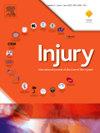评估创伤患者围手术期抗凝持续治疗对DVT/PE率的影响。
IF 2.2
3区 医学
Q3 CRITICAL CARE MEDICINE
Injury-International Journal of the Care of the Injured
Pub Date : 2025-02-01
DOI:10.1016/j.injury.2025.112143
引用次数: 0
摘要
在美国,深静脉血栓形成(DVT)和肺栓塞(PE)在可能预防的医院死亡中排名靠前。创伤患者发生血栓栓塞并发症的风险较高,因此使用各种药物进行预防。多项研究建议在围手术期使用这些药物,以减少额外出血、伤口问题、血肿等潜在并发症。然而,关于保留这些药物的时间和持续时间的数据是不一致的,有时是针对外科医生的。本研究的目的是比较2022年6月在学术创伤中心通过预防性抗凝手术进行政策干预前后创伤患者DVT/PE的发生率。方法:我们比较了我院政策改变前后需要手术的创伤患者的DVT/PE率。该查询包括从2018年1月1日到2023年12月31日的图表。从患者图表中获得与创伤日期、手术日期、损伤类型、抗凝剂给药、DVT/PE发展和死亡(如果适用)相关的临床信息。我们进行了卡方事后分析来评估政策改变前后DVT或PE的发生率。分析集中在两类:有无DVT/PE。结果:术前抗凝治疗后DVT/PE发生改变的可能性是术前抗凝治疗后政策改变的14.553倍(X2 (3, N = 374) =14.553, p= 0.002)。手术前后DVT/PE相关死亡率差异无统计学意义(X2 (1, N = 374) = 0.130, p = .718)。在排除65岁以上患者后,对MVA钝性创伤图表进行分析,结果显示政策前与政策后输血量无统计学差异(X2 (1, N = 174) = 0.2198, p = 0.639)。结论:研究结果表明,政策改变后DVT/PE率显著降低,但死亡率和出血风险未显著增加。本文章由计算机程序翻译,如有差异,请以英文原文为准。
Assessing the impact of perioperative anticoagulant continuation on DVT/PE rates in trauma patients
Introduction
In the United States, deep vein thrombosis (DVT) and pulmonary embolism (PE) ranked high in terms of possibly preventable hospital deaths. Victims of trauma were at a higher risk of developing thromboembolic complications, and thus various agents were used for prophylaxis. Multiple studies recommended holding these agents in the perioperative period to decrease the potential complications of additional bleeding, wound issues, hematoma etc. However, the data regarding the timing and duration of withholding these agents was not consistent and at times surgeon specific. The aim of this study was to compare the incidence of DVT/PE in trauma patients before and after a June 2022 policy intervention to operate through prophylactic anticoagulation at an academic trauma center.
Methods
We compared DVT/PE rates in trauma patients requiring surgery prior to and following policy change at our institution. The query included charts from January 1, 2018, through December 31, 2023. Clinical information relating to trauma date, surgery date, injury type, anticoagulant administration, DVT/PE development, and death, if applicable, was obtained from patient charts. We conducted a chi-square post hoc analysis to evaluate the incidence of DVT or PE before and after a policy change. The analysis focused on two categories: the presence or absence of DVT/PE.
Results
DVT/PE development was 14.553 times more likely pre-policy change when anticoagulation was held prior to surgery compared to post-policy change when anticoagulation was administered before surgery (X2 (3, N = 374) =14.553, p=.002). Mortality related to DVT/PE showed no significant difference between pre-policy and post-policy groups (X2 (1, N = 374) = 0.130, p = .718). After excluding patients over age 65, analysis of MVA blunt trauma charts showed no statistical difference in blood transfusions pre policy v. post policy (X2 (1, N = 174) = 0.2198, p = .639).
Conclusion
Findings suggested that DVT/PE rates have significantly decreased post policy change without a significant increase in mortality and bleeding risk.
求助全文
通过发布文献求助,成功后即可免费获取论文全文。
去求助
来源期刊
CiteScore
4.00
自引率
8.00%
发文量
699
审稿时长
96 days
期刊介绍:
Injury was founded in 1969 and is an international journal dealing with all aspects of trauma care and accident surgery. Our primary aim is to facilitate the exchange of ideas, techniques and information among all members of the trauma team.

 求助内容:
求助内容: 应助结果提醒方式:
应助结果提醒方式:


